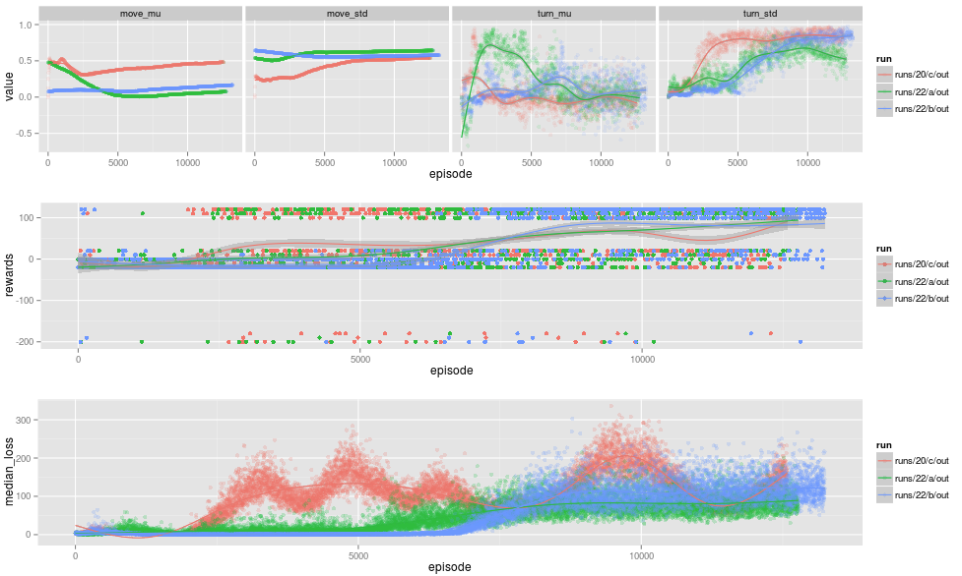malmomo is the third in a series of deep rl projects.
the first was drivebot which trained a DQN to do discrete control of a simulated rover. it included work on using domain adversarial nets to make the controller robust to both simulated & real input but never had the transfer of control from sim to real working properly...
phase 2 was cartpole++ where the focus was on continuous control and raw pixel input. this work included training a baseline likelihood ratio policy gradient method for the low dimensional problem (7d pose of cart and pole) and training DDPG & NAF for the high dimensional raw pixel input version.
phase 3 is malmomo (i.e. mo malmo (i.e. more malmo)). it includes training NAF against a project malmo environment mapping raw pixels to continuous turn/move control. the animation above shows an evaluation in an agent trained in a simpler 2x2 maze that generalises to a larger maze (but still gets stuck in corners :)
- run_trainer.py : runs replay memory & training of networks. reads episode sent from agents via rpc. dump model ckpts to disk on occasion.
- run_agent.py : orchestrates the interaction between malmo and an RL agent. checks/reads new ckpts each episode.
- agents.py : currently describes two agents; a random baseline and one based on a trained NAF network
- replay_memory.py : provides the replay memory functionality for off policy training
- event_log.py : provides the ability to read / write episodes to / from disk
you need to run ....
- a trainer responsible for looking after the replay memory and actually training the network
- N agents running in training mode (i.e. with action noise running as fast as possible)
- N malmo instances, 1 for each agent
- (optionally) a single agent running in eval mode (i.e. no action noise running every 60s or so)
(optionally) you can run a agent in random mode to gather some data to seed the trainers replay memory.
all examples work out of a common working experiment directory; $R
export R=runs/some_experiment/working_dir
to enable / disable verbose debugging issue a kill -sigusr1 to running process.
for the following we'll use N=3
cd $MALMO_INSTALL/Minecraft
./launchClient.sh --port 11100 &
./launchClient.sh --port 11200 &
./launchClient.sh --port 11300 &
if you want to preseed your training replay memory with some random agent actions you can run a random agent for awhile
recording it's actions to an event log... just run this until you're bored... --event-log-out denotes writing the
episodes to a log file and --trainer-port=0 denotes not sending it to any trainer.
./run_agent.py --agent=Random --mission=2 --malmo-ports=11100,11200,11300 --episode-time-sec=30 \
--overclock-rate=4 --post-episode-sleep=0 --event-log-out=$R/random.events --trainer-port=0 \
>$R/agent_rnd.out 2>$R/agent_rnd.err
you can review the random.event file to check number of events and reward distribution
$ ./event_log.py --file $R/random.events
read 52 episodes for a total of 10217 events
$ ./p/reward_freq.sh $R/agent_rnd.out
0.01887 1.0 110
0.03774 2.0 100
0.05660 3.0 20
0.05660 3.0 10
0.35849 19.0 0
0.07547 4.0 -10
0.39623 21.0 -20
or export some/all of the images from the log for review, making animation vizs etc
$ ./event_log.py --file $R/random.events --img-output-dir=$R/imgs
we need one trainer per experiment. it's fine to have multiple running with different grpc ports for the agents to connect to
(and, if training on gpu (HIGHLY recommended) you'll need to have each running on a fraction of gpu memory using
--gpu-mem-fraction. this trainer receives episodes (from agents) and writes ckpts (for agents to reread) every 30sec.
./run_trainer.py \
--replay-memory-size=200000 --ckpt-dir=$R/ckpts --ckpt-save-freq=30 \
>$R/trainer.out 2>$R/trainer.err
run a number of agents in training mode. they can share the malmo instances (in case one crashes) just have each one write to a distinct out/err file... each agent runs at x4 speed and uses offscreen rendering. these agents here don't record their events but could (see the random agent above)
./run_agent.py --agent=Naf --mission=2 --malmo-ports=11100,11200,11300 --episode-time-sec=30 \
--overclock-rate=4 --post-episode-sleep=1 --ckpt-dir=$R/ckpts \
>$R/naf_1.out 2>$R/naf_1.err
it makes sense to run another agent running without any noise to record eval stats. this agent can run an episode every couple of minutes.
./run_agent.py --agent=Naf --mission=2 --malmo-ports=11100,11200,11300 --episode-time-sec=30 \
--eval --overclock-rate=4 --post-episode-sleep=120 --ckpt-dir=$R/ckpts \
>$R/eval.out 2>$R/eval.err
in terms of speed the eval agent above runs as the training ones do, i.e. x4 speed and with offscreen rendering. to eyeball a run you can run an agent at x1 speed with onscreen rendering.
we set --trainer-port=0 so this agent doesn't send it's episodes to the trainer replay memory.
./run_agent.py --agent=Naf --mission=2 --malmo-ports=11100,11200,11300 --episode-time-sec=30 \
--eval --onscreen-rendering --overclock-rate=1 --post-episode-sleep=0 --trainer-port=0 \
--ckpt-dir=$R/ckpts
use plots.sh to visualise action distributions, rewards & net losses over time
use viz_advantage_surface.py to visualise the quadratic q-value surface of the 2d actions
malmomo depends on
- malmo for orchestrating minecraft
- grpc & protobuffers for binary storage and transport of experience data
- minecraft
pip install grpcio grpcio-tools
python -m grpc.tools.protoc -I. --python_out=. --grpc_python_out=. *proto


